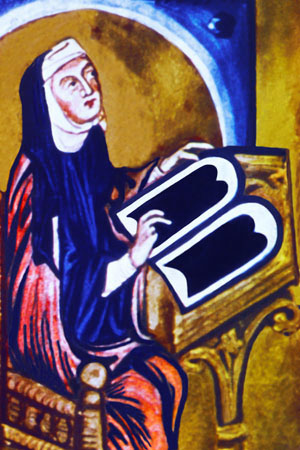
|

|

|

|
Hildegard von BingenHildegard von Bingen was a mystic, composer, healer and natural scientist of the high middle ages. She was born in 1098, the tenth child of landed gentry in Bermersheim near Alzey. She was probably of slight build, with a delicate constitution, suffering throughout her life from health problems. In 1112, Hildegard left her parents' home to enter a convent at Disibodenberg with the Earl of Sponheim's daughter Jutta von Sponheim. This convent lies upon a hill between Staudernheim and Odernheim, not far from where the Glan flows into the Nahe and about 3 kilometres down the Nahe from Bad Sobernheim. Here, Hildegard received a good education upon which she based her later work and writings. However, nothing is known about the first 24 years of her convent life. In the year 1136 however, Jutta von Sponheim died and Hildegard took over the duties of Abbess and stepped the spotlight of history. In the same year (1136), Hildegard began writing down her "visions" in Latin ("Scivias"), supported by her aristocratic student Richardis von Stade and by a monk of the monastery named Vollmar. Her controversial writings were discussed at the Trier Synod in 1147 in the presence of Pope Eugene III and Bernhard von Clairvaux, and this finally led to Hildegard and visionary descriptions becoming officially accepted as within the doctrine of the church. This was a breakthrough for a woman and without precedent at that time. Even today, her rich metaphorical language has lost none of its fascination. Encouraged by this acceptance she fulfilled her ambition to build her own monastery. When she was fifty-three years old, Hildegard received an official allowance from the Abbott Kuno of Disibodenberg to move into her own monastery (founded in 1147) on the Rupertsberg, a hillock near Bingen above where the Nahe flows into the Rhine. This caused some tension with the Abbott of Disibodenberg, but Hildegard's charm ultimately won him over. The new monastery was officially acknowledged as an independent Benedictine monastery on May 22nd, 1158 by the archbishop of Mainz. Built over the tomb of Saint Rupertus, who had worked there 500 years before, the new monastery had many initial difficulties but these were overcome by generous gifts and donations. Just 2 years later, the monastery had the appropriate buildings, including a basilica with two towers. Of crucial significance for the monastery was the scriptorium, where many of Hildegard's writings were composed and illustrated with colourful pictures. One of these was miniature picture depicting Hildegard working on her writings. The shown miniatures are taken from picture boards about a page tall in Hildegard's last work "Liber Divinorum Operum" (1163-1170), the so-called Lucca Codex which is kept in the state library of Lucca/Toscana (Italy). In the year 1160, Hildegard's scientific and medical writings "Physica" and "Causae et Curae" were completed. They contained the entire medical knowledge of the monastery's apothecary. This was essentially holistic medicine that concentrated upon the interactions between body and soul. The monastery on the Rupertsberg also produced most of their own musical and choral works, composed in the late Gregorian style. In the years 1158-1170, four successful sermon tours to various parts of the country (among them Cologne and Trier) brought Hildegard interregional renown. In 1163, her second visionary writings appeared. She became more and more politically influential. In the same year, her monastery was granted official protection by Emperor Barbarossa. Her influence was further enhanced by the founding of a second monastery in 1165 on the other side of the Rhine, in Eibingen near Rüdesheim: monastery Eibingen. Through her works at this time, she became very popular and almost reached the status of a "Saint of the people". In the year 1174, the third book of her trilogy was published ("De Operatione Dei"). In 1178, a rather trivial event caused a conflict between her and the archbishop of Mainz. She had allowed an excommunicated nobleman to be interred in the cemetery of her monastery. This conflict escalated to the point of a church interdiction, but was settled in 1179. Hildegard died shortly after at the age of eighty-one. Hildegard was an exceptional, valiant woman who knew how to prevail against the powerful of her time and who was amazingly 'modern' in many of her ideas. Her scientific work and interest in medicinal questions -rather unusual for a woman at that time- is particularly impressive. Other parts of her writings are difficult for us today but, this aside, her books give us a fascinating and detailed view of the life, culture and way of thinking of the high middle ages. For further information: Wisse die Wege — Scivias. Nach dem Originaltext des illuminierten Rupertsberger Kodex der Wiesbadener Landesbibliothek ins Deutsche übertragen und bearbeitet von Maura Böckeler, 8. Aufl. 1987 Charlotte Kerner: Alle Schönheit des Himmels. Die Lebensgeschichte der Hildegard von Bingen, Beltz & Gelberg, 8. Aufl. 19988 |
|

The picture is from the Lucca Codex and shows Hildegard studying a manuscript. |
|
|
| [ Mail to Webmaster ] info@maasberg.ch |